初中英语时态总结(八大时态精讲)
- 格式:docx
- 大小:48.06 KB
- 文档页数:15
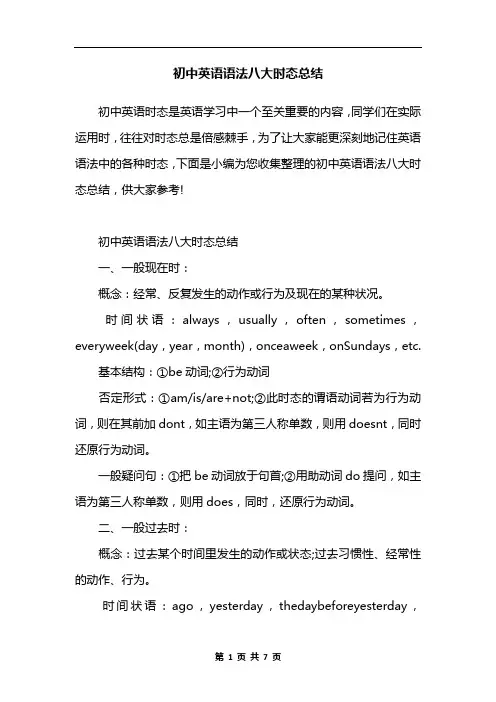
初中英语语法八大时态总结初中英语时态是英语学习中一个至关重要的内容,同学们在实际运用时,往往对时态总是倍感棘手,为了让大家能更深刻地记住英语语法中的各种时态,下面是小编为您收集整理的初中英语语法八大时态总结,供大家参考!初中英语语法八大时态总结一、一般现在时:概念:经常、反复发生的动作或行为及现在的某种状况。
时间状语:always,usually,often,sometimes,everyweek(day,year,month),onceaweek,onSundays,etc.基本结构:①be动词;②行为动词否定形式:①am/is/are+not;②此时态的谓语动词若为行为动词,则在其前加dont,如主语为第三人称单数,则用doesnt,同时还原行为动词。
一般疑问句:①把be动词放于句首;②用助动词do提问,如主语为第三人称单数,则用does,同时,还原行为动词。
二、一般过去时:概念:过去某个时间里发生的动作或状态;过去习惯性、经常性的动作、行为。
时间状语:ago,yesterday,thedaybeforeyesterday,lastweek(year,night,month),in1989,justnow,attheageof5,oneday,longlongago,onceuponatime,etc.基本结构:①be动词;②行为动词否定形式:①was/were+not;②在行为动词前加didnt,同时还原行为动词。
一般疑问句:①was或were放于句首;②用助动词do的过去式did提问,同时还原行为动词。
三、现在进行时:概念:表示现阶段或说话时正在进行的动作及行为。
时间状语:now,atthistime,thesedays,etc.基本结构:am/is/are+doing否定形式:am/is/are+not+doing.一般疑问句:把be动词放于句首。
四、过去进行时:概念:表示过去某段时间或某一时刻正在发生或进行的行为或动作。
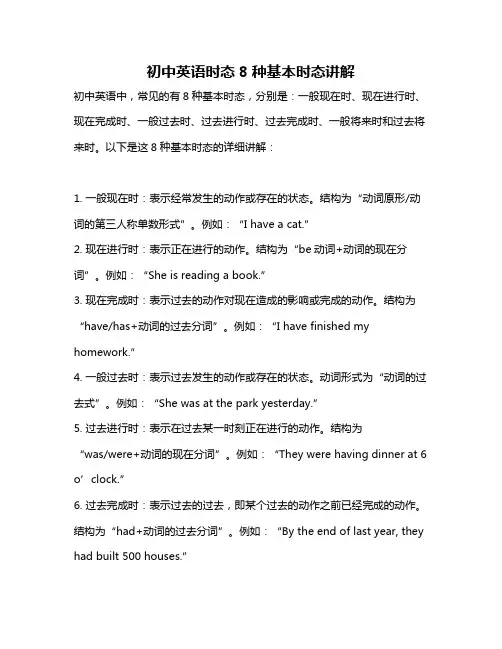
初中英语时态8种基本时态讲解初中英语中,常见的有8种基本时态,分别是:一般现在时、现在进行时、现在完成时、一般过去时、过去进行时、过去完成时、一般将来时和过去将来时。
以下是这8种基本时态的详细讲解:1. 一般现在时:表示经常发生的动作或存在的状态。
结构为“动词原形/动词的第三人称单数形式”。
例如:“I have a cat.”2. 现在进行时:表示正在进行的动作。
结构为“be动词+动词的现在分词”。
例如:“She is reading a book.”3. 现在完成时:表示过去的动作对现在造成的影响或完成的动作。
结构为“have/has+动词的过去分词”。
例如:“I have finished my homework.”4. 一般过去时:表示过去发生的动作或存在的状态。
动词形式为“动词的过去式”。
例如:“She was at the park yesterday.”5. 过去进行时:表示在过去某一时刻正在进行的动作。
结构为“was/were+动词的现在分词”。
例如:“They were having dinner at 6 o’clock.”6. 过去完成时:表示过去的过去,即某个过去的动作之前已经完成的动作。
结构为“had+动词的过去分词”。
例如:“By the end of last year, they had built 500 houses.”7. 一般将来时:表示将来要发生的动作或存在的状态。
结构为“will+动词原形”或“am/is/are going to+动词原形”。
例如:“We will visit the museum next week.”8. 过去将来时:表示从过去的某一时刻看,将来要发生的动作或存在的状态。
结构为“would+动词原形”或“was/were going to+动词原形”。
例如:“He said he would come back soon.”以上就是初中英语8种基本时态的讲解,希望对你有帮助!。
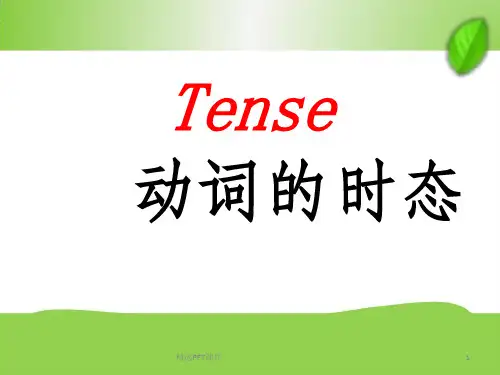
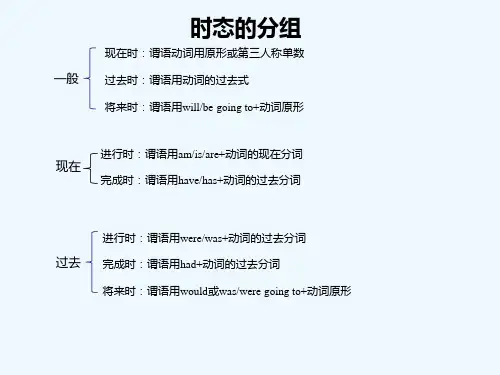
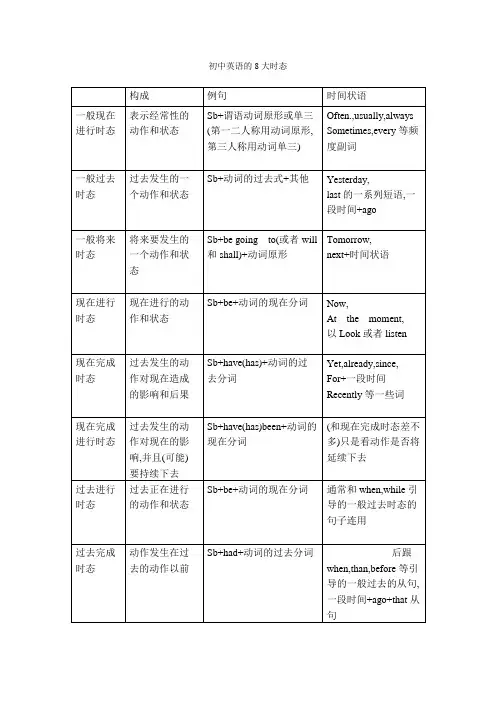
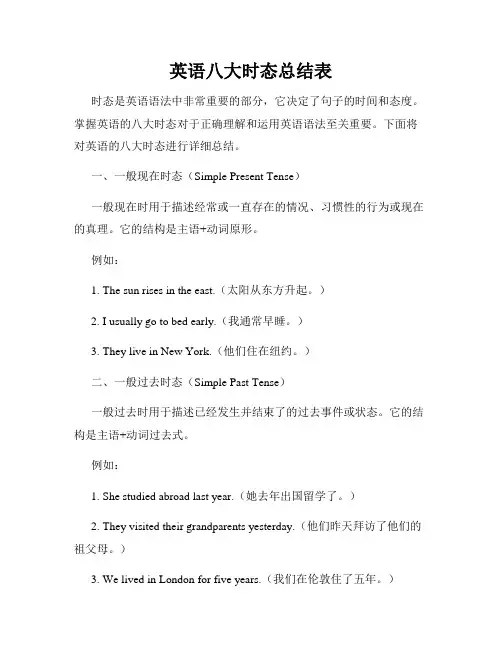
英语八大时态总结表时态是英语语法中非常重要的部分,它决定了句子的时间和态度。
掌握英语的八大时态对于正确理解和运用英语语法至关重要。
下面将对英语的八大时态进行详细总结。
一、一般现在时态(Simple Present Tense)一般现在时用于描述经常或一直存在的情况、习惯性的行为或现在的真理。
它的结构是主语+动词原形。
例如:1. The sun rises in the east.(太阳从东方升起。
)2. I usually go to bed early.(我通常早睡。
)3. They live in New York.(他们住在纽约。
)二、一般过去时态(Simple Past Tense)一般过去时用于描述已经发生并结束了的过去事件或状态。
它的结构是主语+动词过去式。
例如:1. She studied abroad last year.(她去年出国留学了。
)2. They visited their grandparents yesterday.(他们昨天拜访了他们的祖父母。
)3. We lived in London for five years.(我们在伦敦住了五年。
)三、一般将来时态(Simple Future Tense)一般将来时用于描述将来会发生的事件或状态。
它的结构是主语+will+动词原形。
例如:1. I will meet my friends tomorrow.(我明天会见我的朋友。
)2. They will travel to Japan next month.(他们下个月会去日本旅行。
)3. She will study hard for her exams.(她将为考试努力学习。
)四、现在进行时态(Present Continuous Tense)现在进行时用于描述正在进行的动作或当前的情况。
它的结构是主语+am/is/are+动词-ing形式。
例如:1. She is watching TV at the moment.(她此刻正在看电视。
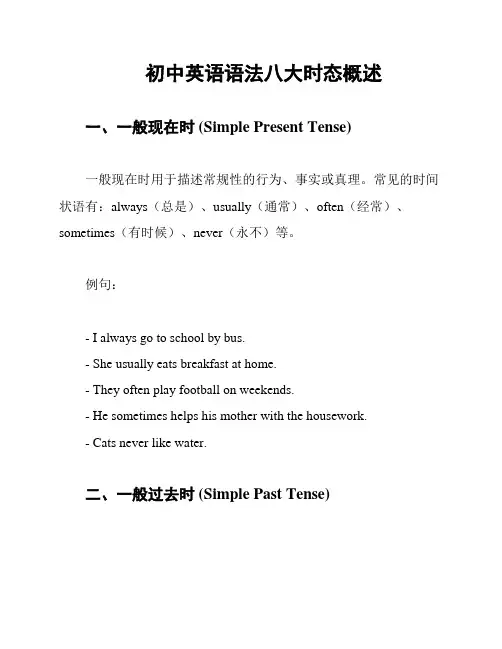
初中英语语法八大时态概述一、一般现在时 (Simple Present Tense)一般现在时用于描述常规性的行为、事实或真理。
常见的时间状语有:always(总是)、usually(通常)、often(经常)、sometimes(有时候)、never(永不)等。
例句:- I always go to school by bus.- She usually eats breakfast at home.- They often play football on weekends.- He sometimes helps his mother with the housework.- Cats never like water.二、一般过去时 (Simple Past Tense)一般过去时用于描述过去发生的事情或存在的状态。
常见的时间状语有:yesterday(昨天)、last week(上周)、two hours ago (两小时前)等。
例句:- I visited my grandparents yesterday.- She bought a new dress last week.- They watched a movie two hours ago.三、一般将来时 (Simple Future Tense)一般将来时用于描述将来要发生的事情或存在的状态。
常见的时间状语有:tomorrow(明天)、next month(下个月)、in a week(一周后)等。
例句:- I will go shopping tomorrow.- She is going to visit her friend next month.- They are going to have a party in a week.四、现在进行时 (Present Continuous Tense)现在进行时用于描述正在进行的动作。
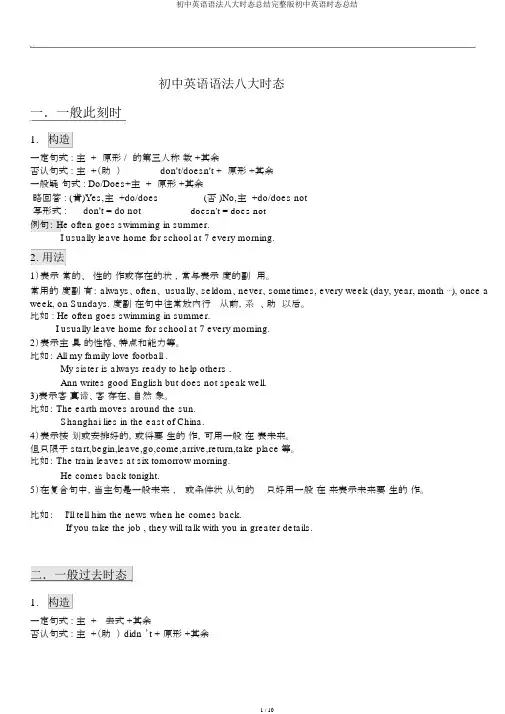
初中英语语法八大时态总结完整版初中英语时态总结初中英语语法八大时态一.一般此刻时1.构造一定句式 : 主 +原形 /的第三人称数 +其余否认句式 : 主 +(助)don't/doesn't +原形 +其余一般疑句式 : Do/Does+主 +原形 +其余略回答 : (肯)Yes,主 +do/does(否 )No,主 +do/does not写形式 : don't = do not doesn't = does not例句: He often goes swimming in summer.I usually leave home for school at 7 every morning.2.用法1)表示常的、性的作或存在的状,常与表示度的副用。
常用的度副有: always、often、 usually、seldom、never、sometimes, every week (day, year, month ⋯), once a week, on Sundays. 度副在句中往常放内行从前,系、助以后。
比如 : He often goes swimming in summer.I usually leave home for school at 7 every morning.2)表示主具的性格、特点和能力等。
比如: All my family love football .My sister is always ready to help others .Ann writes good English but does not speak well.3)表示客真谛、客存在、自然象。
比如: The earth moves around the sun.Shanghai lies in the east of China.4)表示按划或安排好的,或将要生的作,可用一般在表未来。
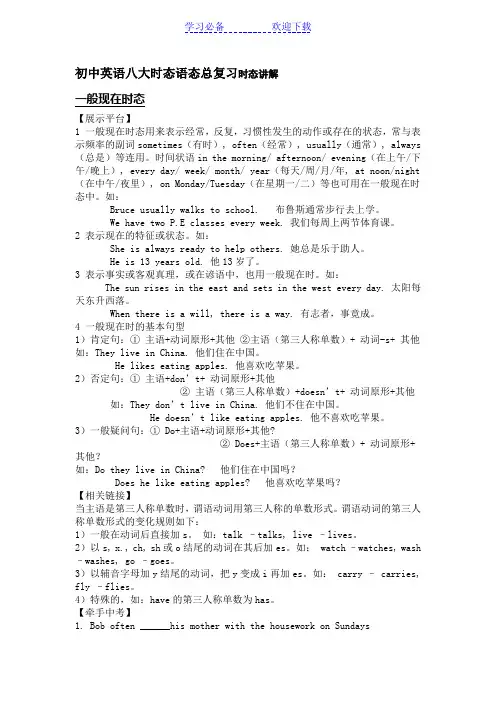
初中英语八大时态语态总复习时态讲解一般现在时态【展示平台】1 一般现在时态用来表示经常,反复,习惯性发生的动作或存在的状态,常与表示频率的副词sometimes(有时), often(经常), usually(通常), always (总是)等连用。
时间状语in the morning/ afternoon/ evening(在上午/下午/晚上), every day/ week/ month/ year(每天/周/月/年, at noon/night (在中午/夜里), on Monday/Tuesday(在星期一/二)等也可用在一般现在时态中。
如:Bruce usually walks to school. 布鲁斯通常步行去上学。
We have two P.E classes every week. 我们每周上两节体育课。
2 表示现在的特征或状态。
如:She is always ready to help others. 她总是乐于助人。
He is 13 years old. 他13岁了。
3 表示事实或客观真理,或在谚语中,也用一般现在时。
如:The sun rises in the east and sets in the west every day. 太阳每天东升西落。
When there is a will, there is a way. 有志者,事竟成。
4 一般现在时的基本句型1)肯定句:① 主语+动词原形+其他②主语(第三人称单数)+ 动词-s+ 其他如:They live in China. 他们住在中国。
He likes eating apples. 他喜欢吃苹果。
2)否定句:① 主语+don’t+ 动词原形+其他② 主语(第三人称单数)+doesn’t+ 动词原形+其他如:They don’t live in China. 他们不住在中国。
He doesn’t like eating apples. 他不喜欢吃苹果。
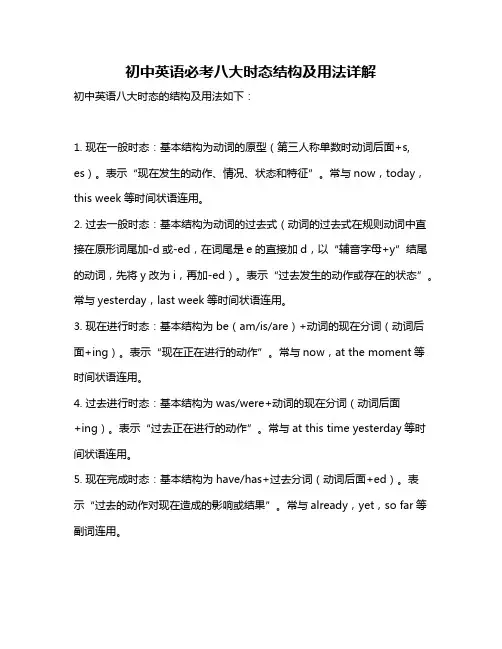
初中英语必考八大时态结构及用法详解初中英语八大时态的结构及用法如下:1. 现在一般时态:基本结构为动词的原型(第三人称单数时动词后面+s, es)。
表示“现在发生的动作、情况、状态和特征”。
常与now,today,this week等时间状语连用。
2. 过去一般时态:基本结构为动词的过去式(动词的过去式在规则动词中直接在原形词尾加-d或-ed,在词尾是e的直接加d,以“辅音字母+y”结尾的动词,先将y改为i,再加-ed)。
表示“过去发生的动作或存在的状态”。
常与yesterday,last week等时间状语连用。
3. 现在进行时态:基本结构为be(am/is/are)+动词的现在分词(动词后面+ing)。
表示“现在正在进行的动作”。
常与now,at the moment等时间状语连用。
4. 过去进行时态:基本结构为was/were+动词的现在分词(动词后面+ing)。
表示“过去正在进行的动作”。
常与at this time yesterday等时间状语连用。
5. 现在完成时态:基本结构为have/has+过去分词(动词后面+ed)。
表示“过去的动作对现在造成的影响或结果”。
常与already,yet,so far等副词连用。
6. 过去完成时态:基本结构为had+过去分词(动词后面+ed)。
表示“过去的动作在过去的某个时间之前已经完成或发生的动作或存在的状态”。
常与by the end of last year,by the time of等时间状语连用。
7. 现在完成进行时态:基本结构为have/has been+动词的现在分词(动词后面+ing)。
表示“动作从过去某时开始,一直延续到现在,或者刚刚完成”。
常与for several days,since等时间状语连用。
8. 过去完成进行时态:基本结构为had been+动词的现在分词(动词后面+ing)。
表示“过去的某个动作从过去某时开始,一直延续到过去的某个时间,或者刚刚完成”。
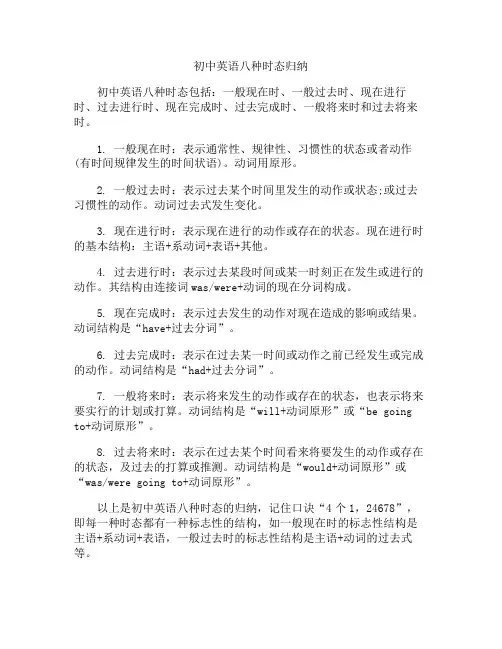
初中英语八种时态归纳
初中英语八种时态包括:一般现在时、一般过去时、现在进行时、过去进行时、现在完成时、过去完成时、一般将来时和过去将来时。
1. 一般现在时:表示通常性、规律性、习惯性的状态或者动作(有时间规律发生的时间状语)。
动词用原形。
2. 一般过去时:表示过去某个时间里发生的动作或状态;或过去习惯性的动作。
动词过去式发生变化。
3. 现在进行时:表示现在进行的动作或存在的状态。
现在进行时的基本结构:主语+系动词+表语+其他。
4. 过去进行时:表示过去某段时间或某一时刻正在发生或进行的动作。
其结构由连接词was/were+动词的现在分词构成。
5. 现在完成时:表示过去发生的动作对现在造成的影响或结果。
动词结构是“have+过去分词”。
6. 过去完成时:表示在过去某一时间或动作之前已经发生或完成的动作。
动词结构是“had+过去分词”。
7. 一般将来时:表示将来发生的动作或存在的状态,也表示将来要实行的计划或打算。
动词结构是“will+动词原形”或“be going to+动词原形”。
8. 过去将来时:表示在过去某个时间看来将要发生的动作或存在的状态,及过去的打算或推测。
动词结构是“would+动词原形”或“was/were going to+动词原形”。
以上是初中英语八种时态的归纳,记住口诀“4个1,24678”,即每一种时态都有一种标志性的结构,如一般现在时的标志性结构是主语+系动词+表语,一般过去时的标志性结构是主语+动词的过去式等。
初中英语八大时态归纳如下:
1. 一般现在时:表示通常性、规律性、习惯性的状态或者动作(有时间规律发生的事件)的一种时间状态。
2. 现在进行时:表示正在进行的动作或存在的状态。
3. 现在完成时:过去发生的动作对现在造成的结果。
4. 现在完成进行时:表示从过去开始一直持续到现在的动作或状态。
5. 一般过去时:表示过去某个时间里发生的动作或状态,或过去习惯性、经常性的动作、行为。
6. 过去进行时:表示过去某个时间正在发生的动作或状态。
7. 过去完成时:表示在过去某个时间或动作之前已经完成了动作。
8. 过去完成进行时:表示过去某个时间或动作之前一直在进行的动作或状态。
希望以上信息能够帮助您更好地理解初中英语的八大时态。
初中英语八大时态全套精讲1. 一般现在时的用法1) 经常性或习惯性的动作,常与表示频度的时间状语连用:every…,sometimes, at…,on SundayI leave home for school at 7 every morning.2) 客观真理,客观存在,科学事实。
The earth moves around the sun. Shanghai lies in the east of China.3) 表示格言或警句中。
Pride goes before a fall. 骄者必败。
注意:以上三种情况用于宾语从句中,即使主句是过去时,从句谓语也要用一般现在时。
例:Columbus proved that the earth is round..4) 现在时刻的状态、能力、性格、个性。
Ann Wang writes good English but does not speak well.比较:Now I put the sugar in the cup. I am doing my homework now.第一句用一般现在时,用于操作演示或指导说明的示范性动作,表示言行的瞬间动作。
再如:Now watch me, I switch on the current and stand back. 第二句中的now 是进行时的标志,表示正在进行的动作的客观状况,所以后句用一般现在时。
二.构成及变化1 、be 动词的变化肯定句:主语+be(am,is,are)+其它。
如:I am a boy. 我是一个男孩。
否定句:主语+ be + not + 其它。
如:He is not a worker. 他不是工人。
一般疑问句:Be +主语+其它。
如:-Are you a student? -Yes. I am. / No, I'm not.特殊疑问句:疑问词+一般疑问句。
如:Where is my bike?2、行为动词的变化当主语为第一,二人称及复数时,助动词为do肯定句:主语+动词原形(+其它)。
如:We often play basketball after school.否定句:主语+ don't+ 动词原形什其它)。
女口:we don' t play basketball after school.一般疑问句:Do +主语+动词原形+其它? 如:Do you often play basketball after school l? Yes, we do. / No, we don't.特殊疑问句:疑问词+以do开头的一般疑问句?女口:W hat do you often do after school ? 当主语为第三人称单数时,助动词为does肯定句:主语+动词三单式(+其它)。
如:He swims well.否定句:主语+ doesn' t+动词原形什其它)。
如:He doesn' t swim well..一般疑问句:Does +主语+动词原形+其它。
如:Does he swim well ?Yes, he does. / No, he doesn't.特殊疑问句:疑问词+以does开头的一般疑问句?如:How does your father go to work?三、第三人称单数的动词变化规则(只有在第三人称为主语的肯定句中,动词才用三单式)(1) 多数动词直接加s:runs gets likes collets takes plays climbs …… .(2) 结尾是s, x, sh, ch, o ,前为辅音字母,结尾加es :watches teaches goes does washes crosses mixes brushes(3) 动词末尾y 前为辅音:将y 改为i 加es:study T studies fly 宀flies carry carries crycries但在 y 前如果为元音则直接加 s: buys says2 一般过去时的用法1)在确定的过去时间里所发生的动作或存在的状态。
时间状语有: yesterday, an hour ago, the other day, in 1982 yesterday morning (afternoon,evenin g…) last ni ght (week, mon th, year …), a mome nt ago , a week ago, three yearsago …just now,等。
Where did you go just now?2) 表示在过去一段时间内,经常性或习惯性的动作。
When I was a child, I often played football in the street.Whenever the Browns went during their visit, they were given a warm welcome. 3) 句型:It is time for sb. to do sth"到……时间了 ""该……了 "It is time sb. did sth. "时间已迟了 " "早该……了 "It is time for you to go to bed. It is time you went to bed. would (had) rather sb. did sth. I'd rather you came tomorrow.4) wish, wonder, think, hope 等用过去时,作试探性的询问、请求、建议等。
I thought you might have some. 我以为你想要一些。
比较:一般过去时表示的动作或状态都已成为过去,现已不复存在。
Christine was an invalid all her life.(含义:她已不在人间。
)Christine has been an invalid all her life. (含义:她现在还活着 ) used to / be used to used to + do :"过去常常”表示过去习惯性的动作或状态,但如今已不存在。
Mother used not to be so forgetful. Scarf used to take a walk. (过去常常散步 )be used to + doing :对 ..... 已感到习惯,或"习惯于”,to 是介词,后需加名词或动名词。
He is used to a vegetarian diet.Scarf is used to taking a walk.( 现在习惯于散步 ) 典型例题 --- Your phone number again? I ___ quite catch it. --- It's 69568442.A. didn'tB. couldn'tC. don'tD. can't答案 A. 本句虽没有明确的时间状语,但从语意上看出,在听的时候没有听懂这个动作发生 在过去,因此应用过去时。
二、构成及变化1. Be 动词在一般过去时中的变化:am 和 is 在一般过去时中变为 was 。
(was not=wasn 't) are 在一般过去时中变为 were 。
(were not=weren ' t)带有 was 或 were 的句子,其否定、疑问的变化和 is, am, are 一样,即否定句在 was 或 were 后加not , —般疑问句把 was 或were 调到句首。
2. 行为动词在一般过去时中的变化:肯定句 : 主语 + 动词的过去式 .I watched a film last Sunday .否定句 : 主语+ didn ' t + 动词原形 .I didn ' t watch a film last Sunday . 一般疑问句: Did + 主语 + 动词原形 ?Did you watch a film last Sunday ? Yes, I did . No , I didn ' t .你该睡觉了。
你早该睡觉了。
表示 '宁愿某人做某事特殊疑问句:疑问词+ 以did 开头的一般疑问句?What did you do last Sunday ?3、现在进行时一、意义——当表示现在正在进行的动作或正在发生的事。
时间标志——now ,句前的look ,listen二、构成:be (am, is ,are )+ 动词现在分词-ing 形式肯定句:主语+ be + 现在分词V-ing (+ 其他)I' m doing my homework now . 否定句:主语+be+not+ 动词-ing + 其他.I' m not doing my homework now.一般疑问句:Be+ 主语+ 动词-ing + 其他?Are you doi ng your home work now?Yes, I am . No , I ' m not .特殊疑问句:特殊疑问词+be+主语+动词-ing+其他?What are you doi ng now ?三、现在分词的构成:(1) 一般在动词末尾直接加ing,⑵以不发音字母e结尾的动词,先去掉e,再加ing,女口skate T skating make making dance dancing write writing have havingride T riding come T coming (3)以重读闭音节结尾的动词,中间只有一个元音字母,词尾只有一个辅音字母,应双写末尾的辅音字母,再加ing, 如:putting running beginning stopping swimmingshopping jogging sitting getting forgetting letting四、现在进行时的基本用法:a. 表示现在( 指说话人说话时) 正在发生的事情。
We are waiting for you.b. 习惯进行:表示长期的或重复性的动作,说话时动作未必正在进行。
Mr. Green is writing another novel. (说话时并未在写,只处于写作的状态。
)She is learning piano under Mr. Smith.c. 表示渐变的动词有:get, grow, become, turn, run, go, begin 等。